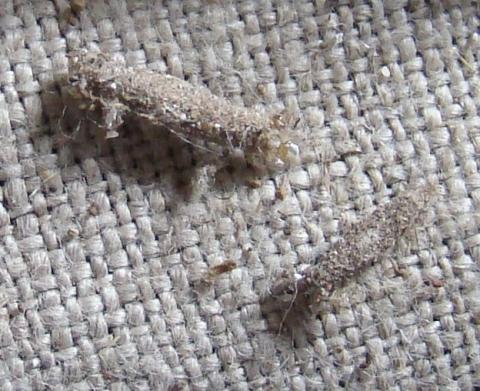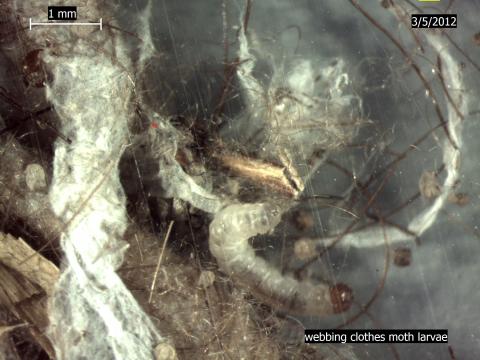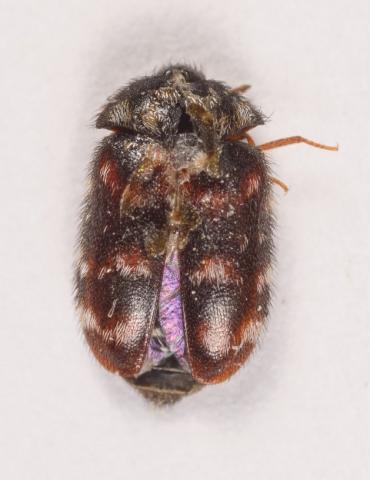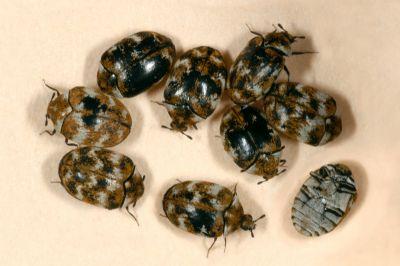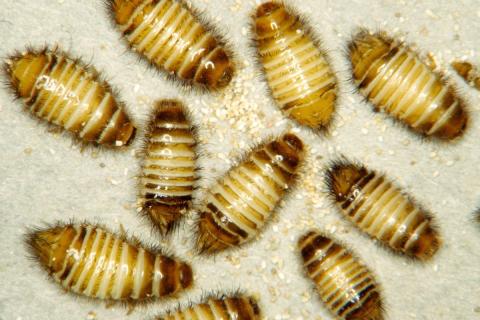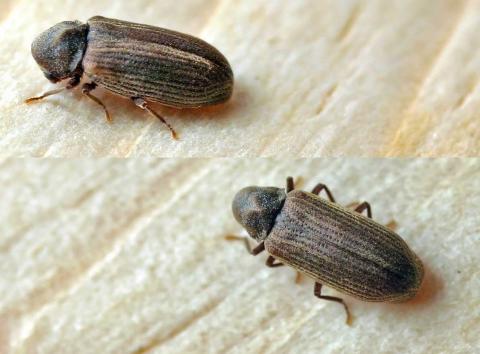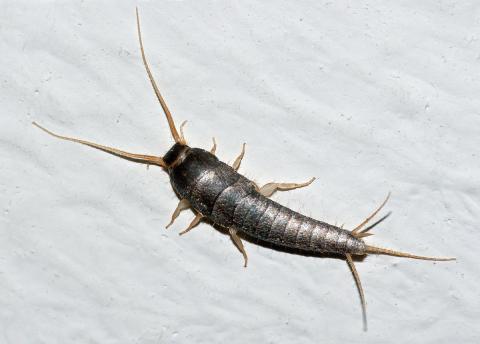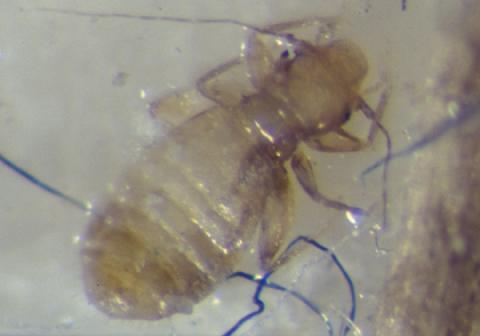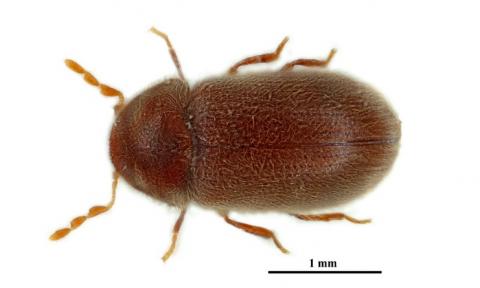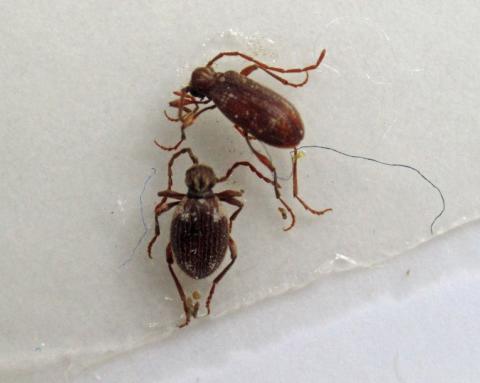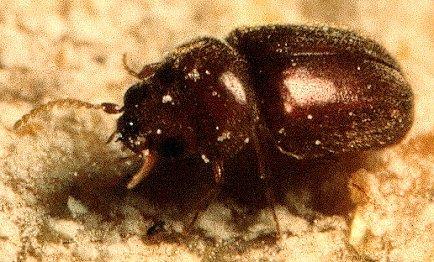Appendix 4: Insect Pests
The summary below of common insect pests is based on information provided in a previous Western Australian Museum publication (1981).
Case-bearing or Case-making Clothes Moth
Figure 1: Cocoons of the case-bearing clothes moth (image courtesy museumpests.net).
- Webbing clothes moth (Tinea biselliella – Figure 2):the moth lays 100 or more very small eggs on almost any fabric or material of animal origin (wool, feathers, fur, hair, skin) particularly if dusty or dirty; • the eggs hatch in about one week and the tiny caterpillars (larvae) do the damage while feeding;
- the larvae are creamy-white with dark heads and are about 12.5 mm long when fully grown;
- the larvae spin cocoons and carry them with them throughout their lives, enlarging the cocoons as necessary; and • when ready to emerge from their cases as moths, the larvae often stray away from their food so that small woven cases containing pupae may occasionally be found suspended from the bare walls or ceiling of a room.
Figure 2: Larva of the webbing clothes moth (image courtesy museumpests.net).
- the larvae of the webbing clothes moth spins a loose silken web or tunnel on the surface of its food material. Dusty or dirty material is preferred;
- the larval stage may last several months or even years;
- when the larva is ready to emerge a silken cocoon is formed, into which small pieces of wood, grass and similar materials are incorporated; and
- the adult emerges after two to five weeks, after which it spends a brief time mating and laying eggs.
Hide Beetle (Family Dermestidae)
Figure 3: Hide beetle (image courtesy museumpests.net).
- the adult beetle is a small ovoid, dark-coloured insect, often with patterns of coloured scales or hairs;
- it is usually found on flowers in the garden;
- the larvae are oval with distinct segments and the body is densely covered with long hairs, some of which may be spear-headed or clubbed;
- the larvae feed on dry animal material of high protein content such as skins, hides, furs, leather and textiles as well as foodstuffs (bacon, cheese); and
- when about to emerge, the larvae leave their food supply and burrow into and consequently damage neighbouring material. The adults, about 6 to 10 mm in length, are often found in materials on which they cannot feed.
Carpet Beetle (Anthrenus sp)
Figure 4: Carpet beetle
(a) Adult carpet beetles.
(b) Carpet beetle larvae.
(image courtesy museumpests.net)
- one of the most common carpet beetles is Anthrenus australid, the Australian carpet beetle;
- the beetle is a small round 3 mm long insect, dark in colour with four distinct wavy white bands across its back, giving it a mottled appearance;
- although commonly found in flower beds, the adult lays its eggs indoors, preferably on materials such as wool, feathers, silk or fur. These serve as a food supply for the larvae;
- the eggs hatch after about 14 days and the larvae may be active for several months depending on temperature and humidity; and
- as they grow the larvae shed their skins. The empty hairy skins are one of the characteristic signs of this insect.
Furniture Beetle (Anobium sp)
Figure 5: Furniture beetle.(By ©entomart, Attribution, https://commons.wikimedia.org/w/index.php?curid=438007).
- the adult beetle lays white, lemon-shaped eggs in cracks and crevices of wooden furniture and timber, particularly in the end grain;
- the eggs hatch in about four to five weeks and the grub then bores into the timber;
- the larvae attack pine, Australian cedar, European oak, beech and elm but not eucalypts;
- when fully grown the larva is about 5 mm long, has dark brown jaws and is covered with short, yellowish hair;
- damage is caused by the burrowing larvae tunnelling into the timber and using the bore dust or ‘frass’ to pack the tunnel behind it;
- the frass may be used as a diagnostic aid with that being produced by Anobium being abundant, loose, gritty and not unlike fine table salt;
- on reaching maturity the larva excavates a small chamber near the wood surface, changes into a pupa and then, in six to eight weeks, into an adult. The adult then bores its way out, leaving an exit hole about 1.5 mm in diameter, to fly away and wreak havoc elsewhere; and
- factors which favour furniture beetle attack are high moisture content, warm environment, wide sapwood, low resin content and the presence of fungal decay in the wood.
Silverfish (Family Lepismatidae)
Figure 6: Silverfish.
(By Christian Fischer, CC BY-SA 3.0, https://commons.wikimedia.org/w/index.php?curid=28984904).
- the silverfish is the most common pest found in paper and textile collections;
- it is rarely seen because of its preference for dark, quiet, humid and secluded places;
- the insect is silvery-grey in colour and when mature is about 15 mm in length;
- the insects emerge from the eggs as miniature adults and grow through a series of moults;
- the life span of this insect can be up to four years. The eggs hatch in ten to sixty days and sexual maturity is reached in two to three months;
- of most concern to collectors are those silverfish which feed on cellulosic materials such as paper, sizing, glue, cotton materials and rotting wood. If unchecked these species can seriously damage books, drawings, prints and cotton fabrics; and
- if a silverfish is detected, inspection of the whole collection and appropriate treatment is needed.
Book Lice (Order Psocoptera)
Figure 7: Adult booklouse (image courtesy museumpests.net).
- are not true lice and are very small (1 – 2 mm in length) with a ‘slightly transparent’ brown colour. The adults do not have wings;
- the young (nymphs) hatch from eggs and look like miniature adults when born
- prefer warm, high humidity environments (conducive to mould growth) in quiet, undisturbed places like under books and paper, in furniture and along the sides of windows;
- feed on microscopic moulds on the surface of paper-based materials, glues, binders and paper sizing and any mouldy plant-based material; and
- damage caused by book lice is similar to that caused by silverfish.
Biscuit or Drugstore Beetle (Stegobium paniceum)
Figure 8: Adult biscuit beetle (image courtesy museumpests.net).
- is a very small brown beetle that is in the same family as the wood-boring beetles (see Furniture beetle above) and is commonly found in old bird nests;
- is similar in appearance to the cigarette beetle but is slightly larger (about 3.5 mm long) and is distinguished by its characteristic antennae, each of end in 3-segmented ‘clubs’;
- the white larvae are very small but active when they hatch, feeding and growing for about 2 months;
- feeds on dried plant matter such as tobacco, nuts and dried plant samples. They may also feed on high starch paper objects (e.g. papier-mache) and dried animal specimens;
- the larvae pupate inside cocoons, often within their food source, before emerging via holes that resemble typical wood-boring exit holes; and
- is capable of causing considerable damage in susceptible materials.
Spider Beetle (Ptinus tectus)
Figure 9: Spider beetle (image courtesy museumpests.net).
- is a small brown insect covered with short hairs;
- larvae are large (5 - 7 mm), yellowish-white with a brown head and a ‘curled’ body covered with fine hairs. The adults are relatively small (2.5 – 4 mm long), slow moving, nocturnal and with a slight resemblance to spiders;
- larvae feed on general debris including other dead insects, boring holes into their food sources. They will infest all types of dry animal and vegetable matter;
- cause damage when the larvae bore holes in which to pupate as well as by contaminating objects with faeces and silk webbing. Adults will also damage packaging such as bags and sacks.
Cigarette Beetle (Lasioderma serricorne)
Figure 10: Cigarette beetle.
(By Andybrookestar (talk) (Uploads) - Own work, Public Domain, https://en.wikipedia.org/w/index.php?curid=9674070).
- the adult is yellowish to reddish brown in colour, about 2.5 mm long and similar in appearance to the biscuit and the common furniture beetle;
- larvae are creamy-white in colour with a worm-like shape. They feed on dried and processed foods, tobacco (obviously!), book bindings and dried plant material; and
- they prefer warm (> 20 °C) dark areas.
Bibliography
Department of Materials Conservation, Western Australian Museum, 1981, Mould and insect attack in museums, in Conservation and Restoration for Small Museums, 2nd Edition, Western Australian Museum, Perth, pp. 20-31.
Museumpests.net – A product of the integrated pest management working group.

